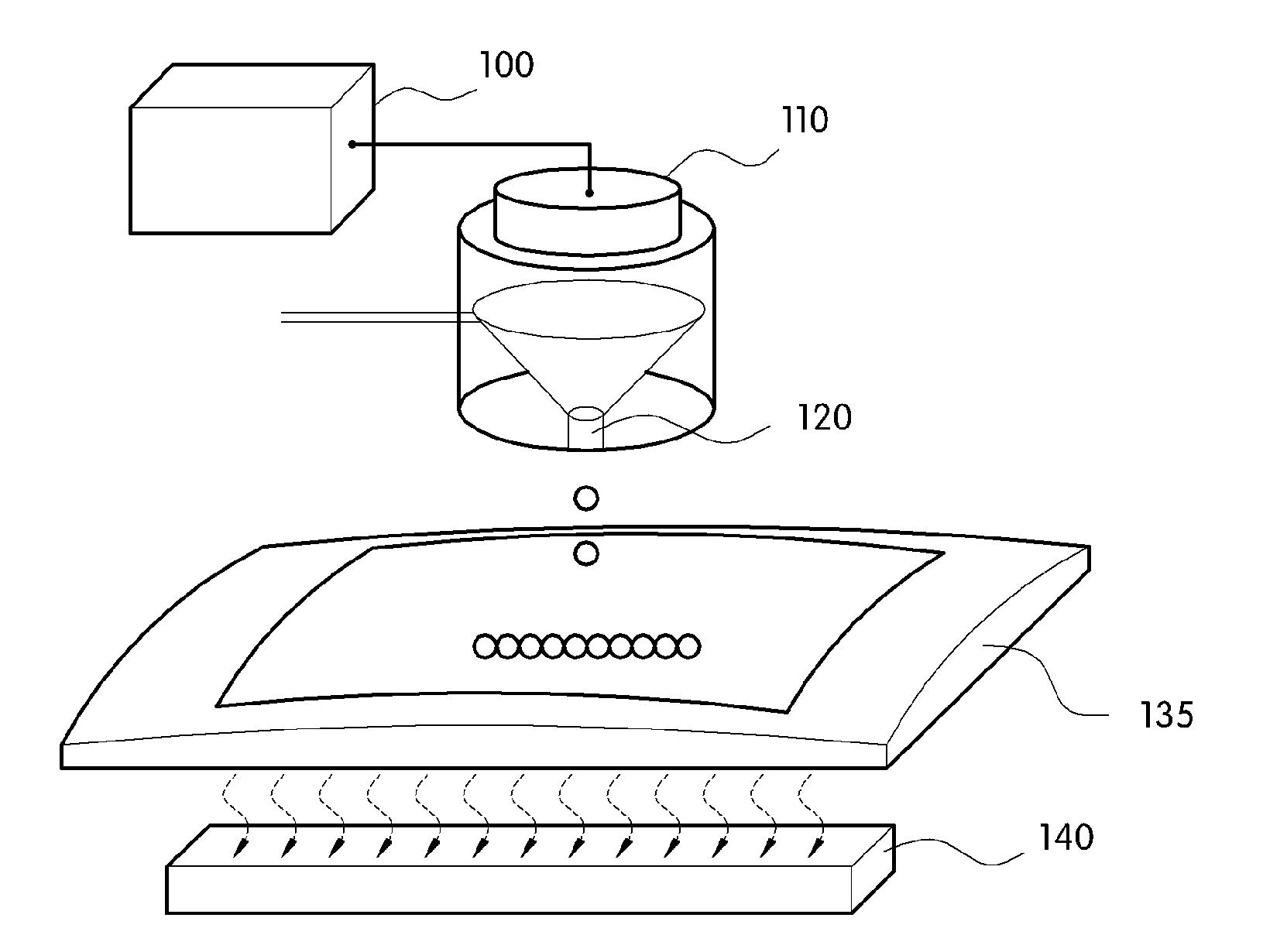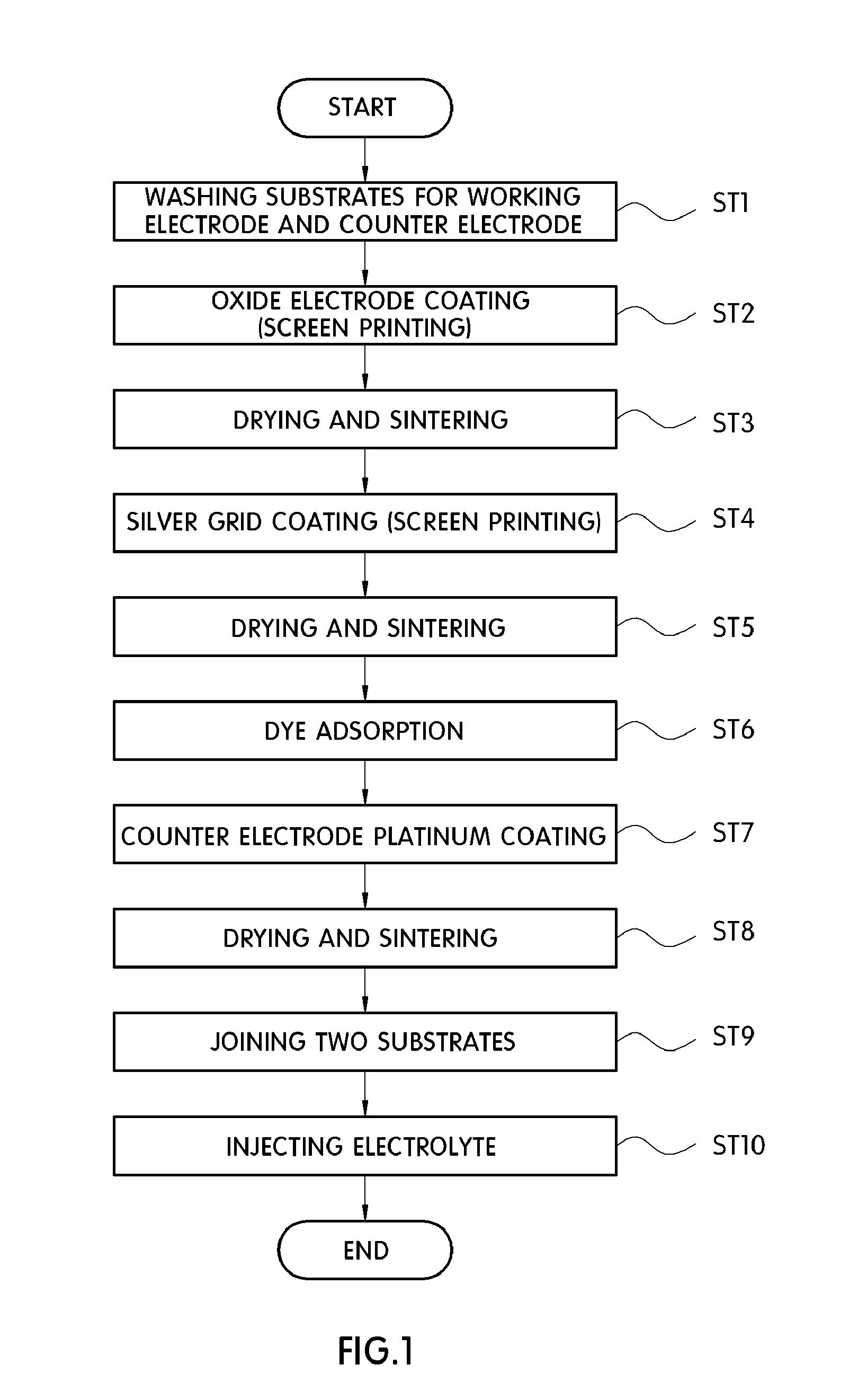Semiconductor oxide ink composition for inkjet printing, method of manufacturing the same, and method of manufacturing photoelectric conversion element using the same
a technology of inkjet printing and semiconductors, applied in the direction of non-metal conductors, liquid/solution decomposition chemical coatings, conductors, etc., can solve the problems of loss of original intended attractiveness of openness, increased production cost, and complex manufacturing process, so as to reduce manufacturing processes and costs
- Summary
- Abstract
- Description
- Claims
- Application Information
AI Technical Summary
Benefits of technology
Problems solved by technology
Method used
Image
Examples
example 1
[0108]Titanium isopropoxide, water, ethanol, and nitric acid were mixed at a mole ratio of 1:1.5:20:0.08, stirred for 4 hrs, and then dried in a vacuum oven at 60° C. for 12 hrs to thereby remove the solvent.
[0109]The resultant material was washed several times by water and ethanol using a filter until pH became neutral, and then dried again in the vacuum oven at 60° C. for 24 hrs.
[0110]The TiO2 nano-particles thus acquired were added to ethanol in an amount of 10 wt %, and then a dispersing agent was further added, such as DisperBYK-180, in an amount of 2 wt % with respect to the weight of the TiO2 nano-particles, followed by circulation and dispersion by a wet-type bead mill for 1 hr.
[0111]Next, 1 wt % methyl cellulose solution (using a solvent obtained by mixing water and ethanol at a weight ratio of 5:5) was added by 5 wt % relative to the weight of the TiO2, and then dispersed for 20 min using a horn-type ultrasonic homogenizer, followed by being subjected to a 3-roll mill to a...
example 2
[0114]Titanium isopropoxide, water, ethanol, and nitric acid were mixed at a mole ratio of 1:1.5:30:0.05 and stirred for 6 hrs, and then dried in a vacuum oven at 60° C. for 12 hrs to thereby remove the solvent.
[0115]The subsequent processes were identical to those of Example 1 except that ethyl cellulose was used as the binder instead of methyl cellulose.
[0116]The thus formed TiO2 ink composition was used to form a TiO2 layer on a curved conductive layer. The resultant TiO2 layer had a thickness of 7 μm.
[0117]A transflective dye-sensitized solar cell module with a size of 100 mm×100 mm was also manufactured using the TiO2 ink composition. The resultant photoelectric conversion efficiency was 4.5%.
example 3
[0118]A semiconductor oxide sol using the same mole ratio as that in Example 2 was created, and then ethanol was removed using an evaporator.
[0119]100 g of the thus formed semiconductor oxide sol was added to a 200 g mixed solvent (a mixture of water and ethanol at a mole ratio of 3:7), followed by addition of 3 g DisperBYK-2001. The thus formed mixture was then circulated and dispersed by a wet-type bead mill for 1 hr.
[0120]Thereafter, the solvent was removed by the evaporator and 200 g of 2-methoxyethanol was added to the resultant TiO2 sol.
[0121]Subsequently, the resultant material was dispersed by a horn-type ultrasonic homogenizer for 20 min, and then added to 10 g polypropylene glycol acrylate, followed by being subjected to a 3-roll mill to adjust the viscosity to 12 cps.
[0122]The thus formed TiO2 ink composition was used to form a TiO2 layer on a curved conductive layer. The resultant TiO2 layer had a thickness of 7 μm, and the photoelectric conversion efficiency of the dye-...
PUM
| Property | Measurement | Unit |
|---|---|---|
| Temperature | aaaaa | aaaaa |
| Time | aaaaa | aaaaa |
| Percent by mass | aaaaa | aaaaa |
Abstract
Description
Claims
Application Information
 Login to View More
Login to View More - R&D
- Intellectual Property
- Life Sciences
- Materials
- Tech Scout
- Unparalleled Data Quality
- Higher Quality Content
- 60% Fewer Hallucinations
Browse by: Latest US Patents, China's latest patents, Technical Efficacy Thesaurus, Application Domain, Technology Topic, Popular Technical Reports.
© 2025 PatSnap. All rights reserved.Legal|Privacy policy|Modern Slavery Act Transparency Statement|Sitemap|About US| Contact US: help@patsnap.com



